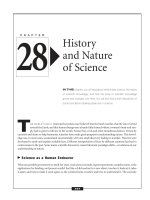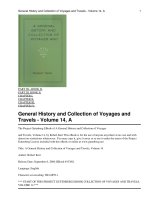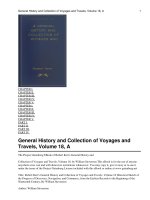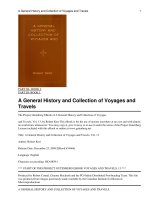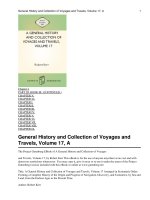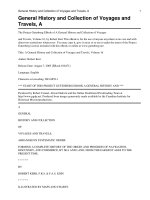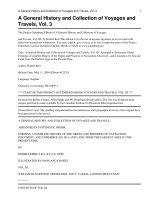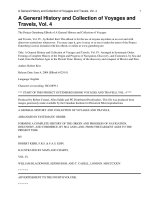15 biology, history, and assessment of western australian abalone fisheries
Bạn đang xem bản rút gọn của tài liệu. Xem và tải ngay bản đầy đủ của tài liệu tại đây (2.61 MB, 96 trang )
Fisheries Research Report No. 241, 2013
Biology, history, and assessment
of Western Australian
abalone fisheries
Anthony M. Hart, Frank Fabris, Jamin Brown and Nick Caputi.
Fisheries Research Division
Western Australian Fisheries and Marine Research Laboratories
PO Box 20 NORTH BEACH, Western Australia 6920
Correct citation:
Hart, A. M., Fabris, F., Brown, J., and Caputi, N. 2013. Biology, history, and assessment of Western Australian
abalone fisheries. Fisheries Research Report No. 241. Department of Fisheries, Western Australia. 96pp.
Enquiries:
WA Fisheries and Marine Research Laboratories, PO Box 20, North Beach, WA 6920
Tel: +61 8 9203 0111
Email:
Website: www.fish.wa.gov.au
ABN: 55 689 794 771
A complete list of Fisheries Research Reports is available online at www.fish.wa.gov.au
This work is copyright. Except as permitted under the copyright Act 1968 (Cth), no part of this publication may
be reproduced by any process, electronic or otherwise, without the specific written permission of the copyright
owners. Neither may information be stored electronically in any form whatsoever without such permission.
© Department of Fisheries, Western Australia. October 2013.
ISSN: 1035 - 4549
ISBN: 978-1-921845-58-1
ii
Fisheries Research Report [Western Australia] No. 241, 2013
Contents
Executive Summary .............................................................................................................
1
Current Fishery....................................................................................................................
3
1.1 Commercial Fishery................................................................................................
3
1.2 Recreational Fishery ...............................................................................................
5
1.3 Illegal Fishery .........................................................................................................
7
2.0 Historical development of the fishery ........................................................................
8
2.1 Catch History ..........................................................................................................
8
2.2 Management History ............................................................................................. 10
3.0 Abalone biology and life history parameters ............................................................ 15
3.1 Greenlip abalone (Haliotis laevigata) .....................................................................
3.1.1 Growth ........................................................................................................
3.1.2 Natural mortality ..........................................................................................
3.1.3 Length-weight relationships ........................................................................
3.1.4 Size-at-maturity and length-fecundity .........................................................
15
15
16
17
19
3.2 Roe’s abalone (Haliotis roei) ..................................................................................
3.2.1 Growth and natural mortality ......................................................................
3.2.2 Length-weight relationships ........................................................................
3.2.3 Size-at-maturity and length-fecundity relationships....................................
19
19
19
19
3.3 Brownlip abalone (Haliotis conicopora) ................................................................
3.3.1 Growth and natural mortality ......................................................................
3.3.2 Length-weight relationships ........................................................................
3.3.3 Size-at-maturity and length-fecundity relationships....................................
22
22
22
23
4.0 Research and assessment methodology ...................................................................... 24
4.1 Commercial fisheries data collection .................................................................... 24
4.1.1 Monthly catch and effort logbooks (1975+)................................................ 24
4.1.2 Daily catch and effort logbooks ................................................................. 24
4.2 Recreational fisheries data collection .....................................................................
4.2.1 Field surveys – Perth metropolitan roe’s abalone fishery ..........................
4.2.2 Weather conditions, license numbers and recreational abalone catch.........
4.2.3 Phone diary surveys – entire state ...............................................................
24
24
24
25
4.3 Fishery independent stock surveys .........................................................................
4.3.1 Research diver transect surveys ...................................................................
4.3.1.1 Greenlip and Brownlip abalone .....................................................
4.3.1.2 Roe’s abalone.................................................................................
4.3.2 Digital video surveys ...................................................................................
25
25
25
27
27
4.4 Data analysis and stock assessment........................................................................
4.4.1 Standardised catch per unit effort ...............................................................
4.4.2 Fishing mortality ..........................................................................................
4.4.2.1 Data................................................................................................
28
28
30
30
Fisheries Research Report [Western Australia] No. 241, 2013
iii
4.4.2.2 Estimation methodology ................................................................ 30
4.4.3 Yield-per-recruit and egg-per-recruit analyses ............................................ 31
4.4.3.1 Sensitivity analysis ........................................................................ 32
4.5 Other Research Projects..........................................................................................
4.5.1 Stock enhancement research (Haliotis laevigata) ........................................
4.5.2 Recovering a collapsed abalone stock through translocation......................
4.5.3 Brownlip abalone: Exploration of wild and cultured harvest potential ......
4.5.4 Marine Park Abalone surveys: Cape Leeuwin – Cape Naturaliste ............
32
32
32
33
33
5.0 Greenlip and Brownlip Abalone ................................................................................. 34
5.1 Commercial fisheries ..............................................................................................
5.1.1 Total Catch, effort and CPUE ......................................................................
5.1.2 Catch, CPUE and meat weights by subregion.............................................
5.1.2.1 Area2ishery.................................................................................
5.1.2.2 Area3ishery.................................................................................
5.1.3 Standardised CPUE......................................................................................
5.1.4 Average meat weight and length-frequency of catch ..................................
5.1.5 Fishing mortality ..........................................................................................
34
34
36
36
36
38
39
42
5.2 Stunted stocks ........................................................................................................
5.2.1 Stunted individuals ......................................................................................
5.2.2 Stunted populations......................................................................................
5.2.3 Stunted stock surveys ..................................................................................
5.2.4 Managing harvest from stunted stocks ........................................................
43
43
43
45
46
5.3 Recreational fisheries ............................................................................................ 47
5.3.1 Catch, effort and CPUE ............................................................................... 47
5.4 Fishery-independent stock surveys .........................................................................
5.4.1 Research Diver Transect Surveys ................................................................
5.4.1.1 Area 2 ............................................................................................
5.4.1.2 Area 3 ............................................................................................
5.4.2 Digital video surveys ...................................................................................
5.4.3 Discussion: FIS trends and limitations...................................................................
48
48
48
51
54
56
5.5 Yield-per-recruit and egg-per-recruit analyses ....................................................... 57
5.5.1 Modelling under assumed growth parameters ............................................. 57
5.5.2 Sensitivity analysis: varying growth parameters ......................................... 58
6.0 Roe’s Abalone ............................................................................................................... 61
6.1 Commercial fisheries .............................................................................................. 61
6.1.1 Catch, effort and CPUE ............................................................................... 61
6.1.2 Standardised CPUE...................................................................................... 61
6.2 Recreational fisheries ............................................................................................ 64
6.2.1 Catch, effort and CPUE ............................................................................... 64
6.2.2 Weather conditions and recreational catch .................................................. 64
6.3 Fishery-independent stock surveys ......................................................................... 66
6.3.1 Research Diver Surveys ............................................................................... 66
iv
Fisheries Research Report [Western Australia] No. 241, 2013
6.3.2 Predicting future Haliotis roei stock densities ............................................. 70
7.0 Performance Indicators and TACC Assessment ....................................................... 71
7.1 Methodology .......................................................................................................... 71
7.2 2012/13 TACC Assessments .................................................................................. 72
7.2.1 Fishery closures ........................................................................................... 73
7.3 Future developments............................................................................................... 73
7.3.1 Egg Production and Fishing Mortality performance measures ................... 73
7.3.2 Harvest Control Rule .................................................................................. 75
8.0 General Discussion ....................................................................................................... 77
9.0 Recommendations for future research ....................................................................... 78
10.0 References ..................................................................................................................... 79
11.0 Appendices .................................................................................................................... 81
11.1 Performance indicators and biological reference points for each management
area and species ......................................................................................................
11.1.1 Area 1 Greenlip and Roe’s abalone fishery .................................................
11.1.2 Area 2 Roe’s abalone fishery .......................................................................
11.1.3 Area 2 Greenlip abalone fishery ..................................................................
11.1.4 Area 3 Greenlip abalone fishery ..................................................................
11.1.5 Area 5 Roe’s abalone fishery .......................................................................
11.1.6 Area 6 Roe’s abalone fishery .......................................................................
11.1.7 Area 7 Roe’s abalone fishery .......................................................................
11.1.8 Area 8 Roe’s abalone fishery .......................................................................
81
81
81
82
82
83
83
84
84
11.2 Catch and Effort maps ............................................................................................ 85
Fisheries Research Report [Western Australia] No. 241, 2013
v
vi
Fisheries Research Report [Western Australia] No. 241, 2013
Executive Summary
This report summarises the biology, demography, research and management relevant to abalone
(Haliotissp.)isheriesinWesternAustraliauptoandincludingthe2011/12season.Itpresents
acomprehensivereviewofcurrentstockassessmentinWesternAustralianabaloneisheries.
Manyofthebiologicalparametershavenotbeenpublishedpreviouslyandrepresentasigniicant
body of work over a number of years.
Abalone isheries operate in shallow coastal waters off the south-west and south coasts of
WesternAustralia and are primarily dive and wade isheries.The majority of catch is taken
bythecommercialishery,howeverthereisalsoasigniicantrecreationalishery,particularly
for Haliotis roei. Three species of abalone are targeted: greenlip abalone (Haliotis laevigata),
brownlip abalone (H. conicopora), and roe’s abalone (H. roei).
The Abalone Managed Fishery is managed primarily through output controls in the form of
Total Allowable Commercial Catches (TACCs), set annually for each species in each area
andallocatedtolicenceholdersasIndividualTransferableQuotas(ITQs)allocatedtospeciic
management areas. The other major management tool is the legal minimum length. Fishery
statusismonitoredusingdailycatchandeffortlogbooks,commercialisherycatchsamples
toestimatemortality,recreationalieldandphone-diarysurveys,andishery-independentdive
surveys using traditional (transect-based) and digital video techniques.
Trendsinbothishery-dependent(standardisedCPUE)andishery-independentsurveysindicate
thatabaloneisherieshavebeensustainablymanagedsincetheirinceptionintheearly1970’s.
Overallthecommercialisherytakes86%(~300t)ofthetotalcatch,with14%(~50t)takenby
therecreationalsector.TheisheryhasundergoneanIntegratedFisheriesManagementprocess
tofacilitatetheallocationofcatchsharesbetweensectors.Catchshareshavebeeninalisedfor
the Perth metropolitan Haliotis roeiishery,withthesectorallocationbeing0.5tcustomary
(~1%),36tcommercial(~47%),and40trecreational(~52%).
TACC assessment using performance indicators and decision rules based on long-term
standardisedCPUEtrendswereundertakenforthe2012/13ishingyear.TotalTACCremained
similartothe2011/12ishingyear.Recreationalcatchisexpectedtoincreasein2012,after
a low harvest in 2011 catch due to poor weather conditions. Further development of TACC
decisionrulestoincludeinformationonharvestrate,ishery-independentabundanceestimates
and sectoral catch allocations will provide greater certainty in the management regime.
Surveys of the Perth metropolitan roe’s abalone stock have resulted in a predictive model for
stockabundance,withthe17–33mmsizeclass(~Age1)showingaclearrelationshipwiththe
≥ 71 mm size class (harvested size class), 4 years later. However recent anomalies in 2011 and
2012 predicted abundances bear further investigation.
Inthecaseofgreenlipabalone,ishery-independentsurveyssuggestthatoverallstocklevels
have been stable over the past 3 to 5 years, but some localised declines and increases in particular
age classes (e.g. ≥ 147mm in the Town sub-area) require further investigation. Further work is
needed in other areas such as the basic biology of brownlip abalone. There is currently limited
informationongrowthforthisspecies,andestimatesofishingmortalityinthisspecieshave
been based on growth assumptions derived from the literature.
Research into stunted greenlip stocks has clearly established the presence of ‘stunting’ in this
species, both from an individual and a stock perspective. However, the research has also shown
that growth and productivity of all greenlip stocks will lie somewhere in a large continuum
Fisheries Research Report [Western Australia] No. 241, 2013
1
from the very stunted, where maximum size reached is less than 120 mm, to the fast growing
areas, where maximum size reached is greater than 180 mm.
Theyield-per-recruitandegg-per-recruitanalysesdemonstratedthattheArea2isherywere
optimallyexploitedwithrespecttoeggconservationtargets,howevertheArea3isherywould
beneitwithsmallyieldincreasesfromminorreductionsinminimumsizeofishing.
Overall,theassessmentsshowthatstocklevelsarecurrentlystableandishingissustainable.
ThisisinconcordancewithanAustralia-widereviewofabaloneisheriesmanagement(Mayield
et. al., 2012). Future research should focus on the following key areas: Improvements and
reinementtotheTACCdecisionrules,researchonthebiologyandisheryofbrownlipabalone,
environmentaleffectsonishingandcatchvariability,developmentofpopulationassessment
modelsandbioeconomicevaluationsofishingpolicy,includingeconomicyield-per-recruit,
and assessment of increases in economic performance under different harvest scenarios
2
Fisheries Research Report [Western Australia] No. 241, 2013
Current Fishery
1.1
Commercial Fishery
TheWesternAustralianabaloneisheryisadiveishery,operatinginshallowcoastalwaters
offthesouth-westandsouthcoastsofWesternAustralia.Theisherytargets3abalonespecies:
greenlip abalone (Haliotis laevigata), brownlip abalone (H. conicopora), and roe’s abalone
(H. roei). Greenlip and brownlip abalone are larger, deeper water species, which can grow
to around 200 mm shell length, and are primarily restricted in distribution to the south coast
(Figure 1). Roe’s abalone are a smaller (growing to 100 mm) species found in commercial
quantities from the South Australian border to Shark Bay, although they are not uniformly
distributed throughout this range (Figure 2).
The principal harvest method is a diver working off ‘hookah’ (surface supplied breathing
apparatus)orSCUBAusinganabalone‘iron’toprisetheshellishoffrocks–bothcommercial
and recreational divers employ this method. Commercial abalone divers operate from small
isheryvessels(generallylessthan9metresinlength).
The Abalone Managed Fishery is managed primarily through output controls in the form of
Total Allowable Commercial Catches (TACCs), set annually for each species in each area and
allocated to licence holders as Individual Transferable Quotas (ITQs). ITQs are speciic to
managementareas(Table1).TheTACCfortheGreenlip/Brownlipisheryisadministered
through 16,100 ITQ units, with a minimum unit holding of 450 units required before a Managed
Fishery License (MFL) can be granted (Table 1). The TACC for Roe’s abalone is administered
through 25,180 ITQ units, with a minimum unit holding of 800 units, although some Roe’s
abalone licences are permitted to operate below this minimum in recognition of historical
ishingpractices.Thelicensingperiodrunsfrom1Aprilto31Marchofthefollowingyearfor
allspeciesandishinggrounds.
AllisheriesareharvestedunderaLegalMinimumLength(LML).TheLMLforgreenlip
and brownlip abalone is 140 mm shell length, although the commercial industry ishes to
self-imposed size limits of 153 mm, 147 mm and 145 mm in various parts of the main stocks
(Table1).Slowgrowingor‘stuntedstocks’arealsoished.Thesestockshavebeenshownto
notgrowtothecurrentLML,andareishedat120mmunderspecialexemptions(seesection
5.2).Stuntedstockishingisstrictlycontrolledtopre-arrangedlevelsofcatchandeffort.
TheLMLforRoe’sabaloneis60mmshelllengthinmostpartsofthecommercialishery
(Table 1). However, commercial LMLs of 75 mm and 70 mm apply in Area 1 (Western
Australia/South Australia border to Point Culver) and Area 7 (Cape Bouvard to Moore River)
respectively.
Fisheries Research Report [Western Australia] No. 241, 2013
3
Figure 1.
Management areas used to set quotas for the commercial greenlip brownlip fishery
in Western Australia. Area 4 currently has no quota allocated
Figure 2.
Map showing the management areas used to set quotas for the Roe’s abalone
commercial fishery in Western Australia.
4
Fisheries Research Report [Western Australia] No. 241, 2013
Table 1.
Management details relevant to commercial abalone fisheries in Western Australian.
Commercial minimum lengths refer to voluntary minimum lengths imposed by
commercial fishers
Species
Area
$No. of
Fishery
Licenses
(MFLs)
Greenlip
1
6
600
3.2
5.33
120
120
2
6
6000
76.8
12.8
140
145
3
8
7200
93.3
12.96
140
147 & 155
1
6
60
0.06
1.0
140
150
2
6
1440
18.0
12.5
140
150
3
8
800
18.0
22.5
140
150
1
12
1980
5
2.52
60
75
2
12
3600
19.8
5.50
60
75
5
12
4000
20.0
5.00
60
60
6
12
2400
12.0
5.00
60
60
7
12
7200
36.0
5.00
60
70
0
60
60
Brownlip
Roe’s
8
12
#ITQs
*Current
TACC (t)
(2011/12)
*Current
value of
ITQs (kg)
Legal
Minimum
Lengths
(mm)
Commercial
Minimum
Lengths (mm)
6000
TOTAL
0
f
315
The12MFLsintheRoe’sabaloneisherygenerallyhaveaccessacrossallManagementZones,whereasinthe
Greenlip/BrownlipisheryMFLsarerestrictedtoindividualmanagementzones.
# Individual Transferable Quota Units
* Whole weight (t) Greenlip and Brownlip TACC. The TACC (and ITQ) are legislated in meat weight, and were
converted to whole weight with a multiplier of 2.667 for Greenlip and 2.5 for Brownlip.
f
This Area is closed under a Section 43 notice so a TACC of zero is set for this area. See section 7.2.1 for more details.
$
1.2
Recreational Fishery
Therecreationalabaloneisheryisdividedinto3zones:theNorthernZoneandWestCoastZone
areexclusivelyRoe’sabaloneisheries,whiletheSouthernZoneispredominantlytheGreenlip
/Brownliprecreationalishery,howeverRoe’sabaloneisalsotakeninthisZone(Figure3).The
recreationalisheryharvestmethodisprimarilywadingandsnorkeling,withthemainfocusof
theisherybeingthePerthmetropolitanstocks(WestCoastFishery),althoughsmalleramountsof
greenlip and brownlip abalone are harvested on compressed air (SCUBA or hookah).
TherecreationalRoe’sabaloneisheryismanagedunderamixofinputandoutputcontrols.
Recreational ishers must purchase a dedicated abalone recreational ishing licence. These
licences are not restricted in number. Total number of licenses currently issued is 18,000 (Figure
4).Historicallyisherscouldalsopurchasean“umbrella”ishinglicense,underwhichabalone
couldbeished(Figure4),howeverthispracticewasdiscontinuedfrom2010.
TheishingseasonintheNorthernandSouthernZonesextendsfrom1Octoberto15May.TheWest
CoastZoneisonlyopenfor5Sundaysannually,andthetimeofishingin2006wasreducedfrom
90to60minutes(between7a.m.and8.00a.m.),commencingontheirstSundayinNovember.
Asummerishingseasonwasintroducedin2011withishingcommencingontheirstSundayof
each month from November to March These restrictive management controls on the west coast
are necessary to ensure the sustainability of an easily accessible (and therefore vulnerable) stock
located adjacent to a population in excess of 1.6 million people (including Geraldton).
Fisheries Research Report [Western Australia] No. 241, 2013
5
Thecombineddailybaglimitforgreenlipandbrownlipabaloneisiveperisher(formerly
10), and the household possession limit (the maximum number that may be stored at a person’s
permanent place of residence) is 20. For Roe’s abalone, the minimum legal size is 60 mm shell
length,thedailybaglimitis20perisher,andthehouseholdpossessionlimitis80.
a)
b)
Figure 3.
6
Maps showing (a) the recreational fishing boundaries for abalone, and (b) the West
Coast (Perth Fishery) zone, showing conservation areas within this zone.
Fisheries Research Report [Western Australia] No. 241, 2013
Figure 4.
1.3
Number of recreational abalone licenses issued during the period 1992 to 2011.
Illegal Fishery
Quantity of illegal take depends on species. Overall, intelligence operations have revealed that
greenlip abalone is the most desirable black market abalone and is easily sold and on sold; roe’s
abalone is of limited desirability, with some local black market trade in the Perth metropolitan
area, and brownlip abalone is not highly sought and has a very limited black market.
Estimates are that at least 3 tonnes of greenlip abalone per year is taken for the black market
on the South Coast. On the West Coast small quantities of excess possession limit metro roes
abalone are taken overseas as hand luggage or baggage to Hong Kong, and Singapore.
Fisheries Research Report [Western Australia] No. 241, 2013
7
2.0
Historical development of the fishery
2.1
Catch History
TheabaloneisheryinWesternAustraliaisAustralia’ssmallest,andishingbeganmoreslowly
than elsewhere because most of the main abalone producing reefs are found in isolated parts of
thestate.Theexceptiontothisistheroe’sabaloneisherynearPerth.Fishingofroe’sabalone
began in 1964, but was minimal and part-time until 1969. Emigration of divers from other states
in 1970 resulted in a rapid expansion of catch to maximum of 450 tonnes before dropping back
to current levels of between 300 and 350 tonnes (Figure 5a). Total catch has been stable since
the early 1970s with an average tonnage around 350 tonnes.
Thegreenlipandbrownlipabaloneisheriesonthesouthcoastarepredominatelycommercial
isheriesandhavebeenthatwaysincetheirinceptionin1970.Greenlipabalonecatchespeaked
at270tonnesintheirstyearoftheishery(1971)andoscillatedbetween150and270tonnes
during the 1970s and 1980s (Figure 5b). Catches dropped rapidly in 1990 to around 150 tonnes
and have been at lower levels ever since, averaging around 190 tonnes (Figure 5b). Initially
the catch was predominately greenlip, with small by catch of brownlip abalone, however since
1985 signiicant amounts of brownlip have been caught and it is now considered a separate
isherywithcatchshowingincreasesinrecentyears(Figure5b).
Asimilarhistoricalpatternisseenintheroe’sabaloneisheries.Commercialcatchesbegan
earliestinthisishery,onthePerthmetropolitanstocksin1964,andthenpeakedat170tonnes
in 1971, before declining to a relatively constant level of around 100 tonnes between 1980 and
2010(Figure5c).Recreationalcatchissigniicantinthisishery,currentlycomprisingaround
40%ofthetotalcatch(Hartetal.,2010).Recreationalcatchestimatesareavailablesince1992,
however considerable recreational catch also occurred in the 1980s. Recent years have seen an
increasing recreational catch and total catch of roe’s abalone in currently estimated to be around
160 tonnes (Figure 5c).
Amoredetailedanalysisofcatchandefforttrendsandinerspatialscalesforindividualspecies
is found in section 11.2.
8
Fisheries Research Report [Western Australia] No. 241, 2013
Figure 5.
Historical catch estimates (tonnes whole weight) from abalone fisheries in Western
Australia. (A) Total Catch, (B) Greenlip and Brownlip catch – commercial only,
(C) Roe’s abalone catch. Historical commercial catches (1964 to 1985) sourced
from Prince and Shepherd (1992), and recreational catch (only estimated post
1991) averaged at 30 – 40% of total for roe’s abalone. For greenlip and brownlip,
recreational catch is minimal (3 – 4% of total; Hart et. al., 2010), and not included here.
Fisheries Research Report [Western Australia] No. 241, 2013
9
2.2
Management History
ManagementinWesternAustralianabaloneisherieshasfollowedasimilarevolutionarypath
tomanyotherisheries,beginningwithsimpleeffortcontrols,developingintomorecomplex
catch controls and spatial management. A brief synopsis of the main signiicant events is
summarised inTable 2, however the ishery has been very adaptive over its time and many
changes have occurred. Only the major developments will be discussed here.
Commercial ishing began in 1964 when there were no controls and the ishery was open
access. By 1971 rapid escalation of catch and license holders prompted the beginning of the
irstsetofeffortcontrols,primarilyfocusedonthePerthmetropolitanroe’sabaloneishery.
These included the setting of minimum size limits, license limitations and the beginning of
spatial management with the use of rolling closures to protect and rest stocks (Table 2). These
practices set the scene for the next decade. Formal spatial management was introduced in 1975
withthecreationofthreemanagementzones(Zone1,2and3).Therelationshipbetweenthese
zones and the current areas is shown in Figure 6. The new management arrangements were
accompanied by catch and effort statistics provided on a monthly basis. The initial licenses
were non-transferable and owner-operated, and this was designed to limit any further expansion
intheishery.
DailybaglimitswereintroducedintothePerthcommercialisheryin1978andremainedfor
20 years. Size limits were initially a combination of minimum lengths and minimum meat
weight, but by 1993, the emphasis on compliance and ensuring management regulations were
enforceable resulted in the adoption of minimum length limits. Changes in size-limits have
been an ongoing and regular management practice in these isheries, as well as ishing area
closures. For example, the Flinders Bay greenlip brownlip ishery in Zone 2 (Area 3) was
regularlyclosedandopened,forperiodsofupto2years,between1975and1996.Thisishery
has been particularly vulnerable because of its small size and ease of access, and has been
intensivelytargetedbyillegalishingatcertainperiodsinitshistory.
The next evolution in management was the period of catch controls, beginning in 1985 with
the setting of a voluntary TAC (TotalAllowable Catch) in the Zone 1 ishery. TACs were
subsequentlyintroducedtotheZone2isheryin1986andtheZone3isheryin1988.Inthe
greenlipbrownlipisheriesthesewereinitiallynon-transferableIQs(IndividualQuotas),setat
quite high levels. However, these were not deemed sustainable and TAC dropped substantially
in1990inthegreenlipbrownlipisheries,asevidencebya40%dropincatch(Figure5b).The
TACintheroe’sabaloneishery(Zone3)wasastate-widecompetitivequota,whichcauseda
fewlocaliseddepletionconcerns,andIQswereeventuallyintroducedintoZone3in1993.
Recreationalishingcontrolswereirstintroducedin1980inthePerthroe’sabaloneishery,
with a 2 month limited season from October to December. However by 1988 concerns with stock
sustainabilityresultedinmorerestrictions;ishingwasonlypermittedonweekendsandpublic
holidays,between6and10am.Thisisheryhassubsequentlyundergonefurtherrestrictions,
resultingina9hourannualisheryin1995,reducedtoa5hourisheryin2010(Table2).The
isherynowalsohasatotalallowablerecreationalcatch(TARC),onlythesecondisheryin
WA to be allocated this under the Integrated Fisheries Management (IFM) initiative. Innovative
ways to control this TARC are now being considered.
The next major management evolution of the commercial ishery management was the
introduction of transferability, unitisation, and spatial TACs in 1999. These changes were
particularly important for the roe’s abalone ishery (the old Zone 3 ishery). Under the new
10
Fisheries Research Report [Western Australia] No. 241, 2013
regime,thespatialTACs(6areasintotal)enabledishingefforttobemoreevenlyspreadacross
theishery.Signiicanttradingofquotaunitswereundertakenbetweenlicenseholderswishing
toishinlocalisedareasclosetohome.
Development of performance indicators and formal decision rules to assess annual TACs was
introduced over the period 2005 – 2009 and these now underlie the main management functions
relating to setting of a sustainable catch.
Fisheries Research Report [Western Australia] No. 241, 2013
11
Historical schedule of significant management action within Western Australian abalone fisheries
IFM
Details
TAC decision rules
Performance indicators
Spatial TAC
ITQs (transferable)
Nominated operators
Quota monitoring
TAC/IQs
Recreational
Catch Controls
Bag limits
Limited entry
Catch Monitoring
Size limits
License limitation
Closures
Effort Controls
Open access
Year
Spatial management
12
Table 2.
Fisheries Research Report [Western Australia] No. 241, 2013
1964
Initial fishing in Perth roe’s abalone fishery. Open access.
1971
License limitation introduced. 36 non-transferable commercial licenses, reduced
to 25 by 1975. Rolling closures begin in Perth fishery on approx. a 3 year rotation
between North, Central, and South areas. System continues till 1982. Size limits
(60 mm) introduced in roe’s abalone fishery.
1972
Minimum size limit (100 mm) introduced for greenlip and brownlip fishery,
corresponding to size at maturity.
1975
Formal spatial management introduced. Three zones created. Zone 1 (6 divers)
and Zone 2 (8 divers) for the greenlip and brownlip fishery. Zone 3 (12 divers) for
the roe’s abalone fishery. Size limits for greenlip and brownlip fisheries changed to
minimum weight of 113 g. Monthly catch and effort monitoring (CAES) introduced
at the spatial scale of 1 degree (60 x 60 nautical miles). Flinders Bay (Zone 2)
greenlip fishery closed for 2 years
1976
Limited entry (owner operated, non-transferable licenses) first introduced in Zone 2.
1978
Daily bag limit (100 kg) introduced for Perth commercial fishery. Remains in place
till 1999 when the 36 tonne spatial TAC introduced. Flinders Bay (Zone 2) greenlip
fishery closed for 18 months
1980
Size limits in Perth fishery increased from 60 to 70 mm. Flinders Bay
(Zone 2) greenlip fishery closed for 2 years. Recreational fishery in Perth limited to
a seasonal opening from mid-October to mid-December.
1985
Total Allowable Catch (TAC) introduced to Zone 1. TAC initially allocated as
non-transferable IQ (Individual Quota). Size limit in greelip and brownlip fishery
increased.
1986
TAC introduced to Zone 2. Flinders Bay (Zone 2) greenlip fishery closed for 2
years. Spatially delimited size limits introduced to Zone 2. Daily catch (quota) and
effort monitoring introduced, initially in Zone 2.
1988
1991 to
1996
1992
1993
1995
1999
2005
2006
2008
2010
2011
Historical schedule of significant management action within Western Australian abalone fisheries
IFM
Details
TAC decision rules
Performance indicators
Spatial TAC
ITQs (transferable)
Nominated operators
Quota monitoring
TAC/IQs
Recreational
Catch Controls
Bag limits
Limited entry
Catch Monitoring
Size limits
License limitation
Spatial management
Effort Controls
Closures
Year
Open access
Fisheries Research Report [Western Australia] No. 241, 2013
Table 2 (continued).
State wide TAC introduced for Zone 3 (roe’s abalone). Recreational fishing further
restricted in Perth fishery. Only permitted on weekends and public holidays
between 6 and 10 am.
Experimental closures and rotational fishing undertaken by industry in Zone 2 greenlip
fishery (Augusta region) to test effectiveness of reef-based management.
13
Nominated operators (i.e. lease divers) permitted in the fishery. Represents first
step away from non-transferability. Daily access hours reduced from 4 to 2 hours on
permitted fishing days in Perth recreational fishery.
IQs introduced in the roe’s abalone fishery to reduce issues stemming from the
competitive TAC. Minimum legal size changed from a meat weight (g) to shell
length (mm) in all fisheries because of compliance concerns.
Permitted fishing days in Perth metro fishery reduced to 6 days in total during
November / December creating a 9 hour annual fishery.
TAC unitised, quota made transferable (ITQs), and fishery divided into 8 new spatial
units (Area 1 to Area 8) each with its own TAC. See Figure 6 for a comparison of
“old” and “new” spatial areas.
Formal performance indicators introduced to monitor stock status and assist in TAC
assessment process.
Permitted fishing hours in Perth metro fishery reduced to 1 hour per day resulting in
a 6 hour annual fishery
TAC decision rules introduced. Integrated Fisheries Management (IFM), which
determines sectoral catch allocations, introduced for the Perth roe’s abalone fishery.
Recreational fishery now has total allowable catch.
Permitted fishing hours in Perth metro fishery reduced to 5 days in total during
November/Decemberr resulting in a 5 hour annual fishery
Permitted fishing days in Perth metro fishery changed from 5 consecutive weeks
in November/December to a Summer season starting on the first Sunday of each
month from November through March
Figure 6.
14
General map comparing old zonal arrangements (1975-1998; Zone 1, 2 & 3) and
new area management areas (1999-2012+) of the commercial abalone fisheries of
Western Australia
Fisheries Research Report [Western Australia] No. 241, 2013
3.0
Abalone biology and life history parameters
Abalone are marine archaeogastropods (snails) with a worldwide distribution in tropical and
temperate waters (Lindberg, 1992). All commercially targeted Western Australian species of
abalone live on exposed, high-energy coasts and have evolved life-history characteristics to
enable survival in this environment. General traits include: a muscular foot capable of providing
solid attachment during periods of prolonged exposure; a feeding behaviour primarily focused
on drifting algae dislodged by wave action, rather than actively grazing as do many other
gastropods herbivores (Shepherd and Steinberg, 1992); broadcast spawning by separate sexes,
synchronised by seasonal cue’s such as change in water temperature and lunar periods, and a
relatively short larval life-span of between 5 and 10 days to allow for quick settlement back
into localised populations (McShane, 1992); use of specialised larval settlement substrate such
as crustose coralline algae, and a relatively slow and long-lived life duration (McShane, 1992).
Managing harvest of these species requires detailed knowledge of the speciic biology and
habitat such as growth and mortality rates, length-weight relationships, and reproductive
characteristics such as size-at-maturity and fecundity.
3.1
Greenlip abalone (Haliotis laevigata)
3.1.1
Growth
GrowthofgreenlipabaloneinWesternAustraliavariessigniicantlybetweenpopulations.At
the faster end, greenlip abalone populations reach an average maximum size of 175 mm (Table
3). At the lower end of the growth spectrum, stunted stocks show an average maximum size
of 125 – 133 mm shell length, which is below the legal minimum length (Table 3). This is a
difference in growth of between 12 and 38 mm yr-1 for an 80 mm animal in different areas.
Allabaloneexhibitlargespatialheterogeneityingrowth,with“stunted”populationsoccurringin
allabaloneisheries(WellsandMulvay,1995).Toensureoptimalandsustainableexploitation,
populations with different growth characteristics require harvest strategies that account for this
variability. Typically this is achieved via the use of spatially varying size-limits and TACCs
matched to the productivity of the population (Mayield and Saunders, 2008; Prince et al.,
2008,Tarbath and Oficer, 2003). In the case of Haliotis laevigata, comparisons of growth
parameters from tag-recapture studies across Australia reveal a wide variability within and
betweenisheries(Figure7).
Fisheries Research Report [Western Australia] No. 241, 2013
15
Figure 7.
3.1.2
Von Bertalanffy growth parameters (K, L∝) from Haliotis laevigata populations
within and between state fisheries in Australia. Data have been grouped into
“stunted”, “normal” and “fast” growth stocks in relation to the LML of 140 mmm
(dashed line) for the Western Australian fishery. Growth parameters sourced from:
this report (Table 3), Mayfield et al., (2003), Officer (1999), Shepherd and Hearn
(1983), Shepherd et al. (1992), Wells and Mulvay (1995).
Natural mortality
Natural mortality (M) in adult greenlip abalone has been estimated between 0.15 and 0.4,
dependingonmethodandlocation(Table3).ForthemostpartMisassumedtobe0.25(22%
perannum)forWA’scommerciallyishedpopulation.
To obtain an estimate of ishing mortality from length-frequency data, growth assumptions
were made to represent the entire stock in different areas (Table 3). These growth parameters
provided the best it for length-converted catch-curve estimates of Z and are a reasonable
representation of average growth for the overall population. See section 5.1.5.
16
Fisheries Research Report [Western Australia] No. 241, 2013
Table 3.
Natural mortality and growth information for Haliotis laevigata from Western
Australia. Growth is estimated from tag-recapture data and growth assumptions
are made for model estimates of fishing mortality based on length-converted catch
curves (see section 5.1.5) and yield-per-recruit analysis (see section 5.5).
Natural
Mortality
(M)
Location
All
Growth
parameters (von
Bertalannfy)*
K
L∝ (±SD)
Growth rate
(mm.y-1) for
an 80 mm
animal
0.25
South Australia
Source
Unpublished data
0.15 – 0.40
Mayfield et al.
(2003)
Growth estimates from tag-recapture
Augusta (Outback)
0.55
170 (14)
38
Hart et al. (1999)
Augusta (Flinders Bay)
0.36
165 (10)
34
Wells and
Mulvay (1995)
Hopetoun
(2 Mile Main stocks)
0.33
145 (14)
29
Unpublished data
Hopetoun
(2 Mile stunted stocks)
0.34
133 (13)
12
Unpublished data
Station Island (Duke of
Orleans Bay) – stunted
0.60
128 (12)
22
Unpublished data
Pt Malcolm (Israelite
Bay) – stunted
0.55
124 (9)
18
Unpublished data
Growth parameters for length-converted catch curve and yield-per-recruit analysis
West Coast (Augusta)
0.30
185
27
South Coast (Area 3)
0.25
179
22
Area 2
0.25
179
22
* Growth parameters estimated using maximum likelihood (see Francis, 1988)
3.1.3
Length-weight relationships
Length-weight relationships for greenlip abalone in Western Australia are summarised in Figure
8. Relationships vary slightly between areas, for example a 160 mm animal at Flinders Bay,
Augusta has an average meat weight of 230 g, compared to 186 g for the same-sized animal at
Windy Harbour (Figure 8).
Fisheries Research Report [Western Australia] No. 241, 2013
17
1000
whole weight
meat weight
(A)
1000
900
900
Weight (g)
800
700
600
600
500
a = 7 x 10-6
b = 3.402
400
200
200
100
100
0
0
60
80
(C)
1000
Weight (g)
60
80
(D)
800
a = 5x10-5
b = 3.213
700
600
500
500
400
a = 1 x 10-5
b = 3.298
300
300
200
100
100
0
0
60
80
40
100 120 140 160 180
(E)
400
900
a = 5 x 10-6
b = 3.452
400
200
40
a = 4x10-5
b = 3.281
700
600
60
80
(A)
(B)
(C)
(D)
(E)
300
700
250
600
a = 2x10-5
b = 3.47
500
100 120 140 160 180
(F)
350
800
200
400
150
300
a = 3 x 10-6
b = 3.61
200
100
100
50
0
0
40
60
80
100 120 140 160 180
Length (mm)
Figure 8.
100 120 140 160 180
900
800
Weight (g)
40
100 120 140 160 180
900
18
400
300
40
a = 9 x 10-6
b = 3.363
500
300
1000
a = 3x10-5
b = 3.343
800
a = 5x10-5
b = 3.211
700
1000
(B)
40
60
80
100 120 140 160 180
Length (mm)
Length-whole weight (blue line), and length-meat weight (red line) relationships for
Haliotis laevigata at 5 sites in Western Australia: A) Augusta (outback); B) Augusta
(Flinders Bay); C) Windy Harbour; D) Hopetoun; E) Point Malcolm, F) comparison of
length – meat weight relationships between areas. The equation is W=aLb
Fisheries Research Report [Western Australia] No. 241, 2013
3.1.4
Size-at-maturity and length-fecundity
Size-at-maturity and length-fecundity relationships for greenlip abalone in Western Australia
are summarised in Table 4. Average size-at-maturity for females varies between 78 and 97 mm
(Table 4), and appears to be primarily dependent on growth rate. Based on growth data, ageat-maturity is expected to be about 3 years, although there is some evidence that maturation is
not entirely age dependent, and can be accelerated under optimal conditions (McAvaney et al.,
2004). However there are generally at least 2 breeding years protected by the LML of 140 mm.
Table 4.
Size-at-maturity and length-fecundity relationships for Haliotis laevigata at 6 sites
in Western Australia. Length-fecundity equations are of the form F =aLb, where F is
fecundity (millions of eggs), and L is length (mm)
Size at
50% maturity
(mm)
Location
Augusta (fast)
Augusta (normal)
Augusta (stunted)
Cape Arid (normal)
Cape Arid (stunted)
a
Source
b
97
1.00 × 10-6
5.48
Hart et al. (2000)
87
1.49 ×
10-3
4.29
Wells and Mulvay (1992)
1.39 ×
10-4
4.70
Wells and Mulvay (1992)
6.91 ×
10-4
4.42
Wells and Mulvay (1992)
4.95 ×
10-5
4.99
Wells and Mulvay (1992)
6.19 ×
10-4
4.42
Wells and Mulvay (1992)
78
Hopetoun (normal)
Hopetoun (stunted)
Length-Fecundity
parameters
81
88
85
Wells and Mulvay (1992)
3.2
Roe’s abalone (Haliotis roei)
3.2.1
Growth and natural mortality
Estimates of natural mortality (M) of adult roe’s abalone vary between 0.13 and 0.17, or between
12and16%perannum(Table5).
Growthofroe’sabalonevariessigniicantlybetweenpopulations.Atthehigherrange,roe’s
abalone reach an average maximum size of 89 mm (Table 5). At the lower end of the growth
spectrum, slow growing stocks show an average maximum size of 73 – 75 mm shell length
(Table 5). This is a difference in growth of between 6 and 14 mm yr-1 for a 40 mm animal.
To obtain an estimate of ishing mortality from length-frequency data, growth assumptions
were made to represent the entire stocks in different areas (Table 5). These growth parameters
provided the best it for length-converted catch-curve estimates of Z and are a reasonable
representation of average growth for the overall population.
3.2.2
Length-weight relationships
Length-weight relationships for roe’s abalone in Western Australia are summarised in Figure 9.
3.2.3
Size-at-maturity and length-fecundity relationships
Size-at-maturity and length-fecundity relationships for roe’s abalone in Western Australia are
summarised in Table 6. Size–at-maturity for females is around 40 mm shell length. Based on
growth data, age-at-maturity is expected to be about 3 years, similar to greenlip and brownlip
abalone. There are generally one or two breeding years protected by the LML of 60 mm.
Fisheries Research Report [Western Australia] No. 241, 2013
19
